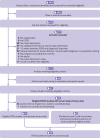Accuracy of the Edinburgh Postnatal Depression Scale (EPDS) for screening to detect major depression among pregnant and postpartum women: systematic review and meta-analysis of individual participant data
- PMID: 33177069
- PMCID: PMC7656313
- DOI: 10.1136/bmj.m4022
Accuracy of the Edinburgh Postnatal Depression Scale (EPDS) for screening to detect major depression among pregnant and postpartum women: systematic review and meta-analysis of individual participant data
Abstract
Objective: To evaluate the Edinburgh Postnatal Depression Scale (EPDS) for screening to detect major depression in pregnant and postpartum women.
Design: Individual participant data meta-analysis.
Data sources: Medline, Medline In-Process and Other Non-Indexed Citations, PsycINFO, and Web of Science (from inception to 3 October 2018).
Eligibility criteria for selecting studies: Eligible datasets included EPDS scores and major depression classification based on validated diagnostic interviews. Bivariate random effects meta-analysis was used to estimate EPDS sensitivity and specificity compared with semi-structured, fully structured (Mini International Neuropsychiatric Interview (MINI) excluded), and MINI diagnostic interviews separately using individual participant data. One stage meta-regression was used to examine accuracy by reference standard categories and participant characteristics.
Results: Individual participant data were obtained from 58 of 83 eligible studies (70%; 15 557 of 22 788 eligible participants (68%), 2069 with major depression). Combined sensitivity and specificity was maximised at a cut-off value of 11 or higher across reference standards. Among studies with a semi-structured interview (36 studies, 9066 participants, 1330 with major depression), sensitivity and specificity were 0.85 (95% confidence interval 0.79 to 0.90) and 0.84 (0.79 to 0.88) for a cut-off value of 10 or higher, 0.81 (0.75 to 0.87) and 0.88 (0.85 to 0.91) for a cut-off value of 11 or higher, and 0.66 (0.58 to 0.74) and 0.95 (0.92 to 0.96) for a cut-off value of 13 or higher, respectively. Accuracy was similar across reference standards and subgroups, including for pregnant and postpartum women.
Conclusions: An EPDS cut-off value of 11 or higher maximised combined sensitivity and specificity; a cut-off value of 13 or higher was less sensitive but more specific. To identify pregnant and postpartum women with higher symptom levels, a cut-off of 13 or higher could be used. Lower cut-off values could be used if the intention is to avoid false negatives and identify most patients who meet diagnostic criteria.
Registration: PROSPERO (CRD42015024785).
© Author(s) (or their employer(s)) 2019. Re-use permitted under CC BY-NC. No commercial re-use. See rights and permissions. Published by BMJ.
Conflict of interest statement
Competing interests: All authors have completed the ICMJE uniform disclosure form at www.icmje.org/coi_disclosure.pdf and declare: support from Canadian Institutes of Health Research for the submitted work; no financial relationships with any organisations that might have an interest in the submitted work in the previous three years with the following exceptions: MTo declares that he has received a grant from Merck Canada, outside the submitted work; SNV declares that she receives royalties from UpToDate, outside the submitted work; CTB declares that she receives royalties for her Postpartum Depression Screening Scale published by Western Psychological Services; PMBo declares that he receives grants and personal fees from Servier, grants from Lundbeck, and personal fees from AstraZeneca, all outside the submitted work; LMH declares that she has received personal fees from NICE Scientific Advice, outside the submitted work; ISP declares that she has served on advisory boards and acted as invited speaker at scientific meetings for MSD, Novo Nordisk, Bayer Health Care, and Lundbeck A/S; KAY declares that she receives royalties from UpToDate, outside the submitted work. All authors declare no other relationships or activities that could appear to have influenced the submitted work. No funder had any role in the design and conduct of the study; collection, management, analysis, and interpretation of the data; preparation, review, or approval of the manuscript; and decision to submit the manuscript for publication.
Figures


References
-
- National Institute for Health and Care Excellence Antenatal and postnatal mental health: Clinical management and service guidance. British Psychological Society, 2014. - PubMed
Publication types
MeSH terms
Grants and funding
LinkOut - more resources
Full Text Sources
Medical
